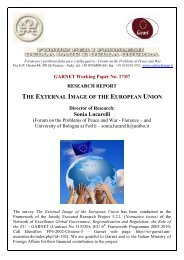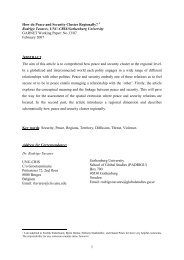1 Gender Knowledge in Economic Migration Theories and in - Garnet
1 Gender Knowledge in Economic Migration Theories and in - Garnet
1 Gender Knowledge in Economic Migration Theories and in - Garnet
Create successful ePaper yourself
Turn your PDF publications into a flip-book with our unique Google optimized e-Paper software.
st<strong>and</strong>ard accounts of <strong>in</strong>dividual <strong>and</strong> family migration with<strong>in</strong> economics. From a poststructuralist<br />
perspective, which takes economics serious as “a discourse, which actively<br />
produces its objects as well as its subjects of knowledge” (Hewitson 2001: 223), it can<br />
therefore be argued that both models participate <strong>in</strong> sett<strong>in</strong>g a certa<strong>in</strong> type of mascul<strong>in</strong>ity as the<br />
norm while fram<strong>in</strong>g less privileged subject positions <strong>and</strong> the respective <strong>in</strong>fluences on<br />
migration patterns <strong>and</strong> experiences as deviant <strong>and</strong> somehow irrelevant.<br />
Historical legacies: why women disappeared from migration studies<br />
Even though today a plethora of empirical studies <strong>and</strong> theoretical contributions on gender <strong>and</strong><br />
migration as well as on women <strong>and</strong> migration exists, gender has still not successfully been<br />
<strong>in</strong>tegrated <strong>in</strong>to the ma<strong>in</strong>stream of migration studies, ‘women’ are mostly added or relegated<br />
to chapters of ‘family <strong>and</strong> household’ <strong>and</strong> ‘gender’ is still equated with ‘women’. An<br />
<strong>in</strong>sightful example is the International <strong>Migration</strong> Review (IMR), the lead<strong>in</strong>g journal <strong>in</strong> the<br />
field. In 1984, Mirjana Morokvasic edited a special IMR-volume on “Women <strong>in</strong> <strong>Migration</strong>”<br />
<strong>in</strong> which she made research on female migration visible <strong>and</strong> criticized most migration<br />
theories for offer<strong>in</strong>g only very narrow explanations for the movement of women (Morokvasic<br />
1984: 896ff.). Twenty years later a special IMR-issue on the “general” state of the art<br />
(Portes/DeW<strong>in</strong>d 2004) did not even conta<strong>in</strong> a piece on gender <strong>and</strong> migration, let alone papers<br />
which <strong>in</strong>cluded the gender dimension, except for one anthropological contribution<br />
(Levitt/Schiller 2004). Moreover, the edited volume “<strong>Migration</strong> Theory. Talk<strong>in</strong>g Across<br />
Discipl<strong>in</strong>es” (Brettell/Hollifield 2000b), a major reference for migration scholars, does not at<br />
all <strong>in</strong>clude gender issues, except for, aga<strong>in</strong>, the article on anthropology (Brettell 2000). In the<br />
follow<strong>in</strong>g section we briefly move back <strong>in</strong> history to trace back the academic reason<strong>in</strong>g about<br />
migratory movements. This “suggests where, when, <strong>and</strong> by whom particular modes of<br />
th<strong>in</strong>k<strong>in</strong>g about migration earned the imprimatur of theory, <strong>and</strong> why work by female<br />
researchers on women or gender so rarely achieved that status” (Donato et al. 2006: 8). There<br />
are at least five reasons for it: The exclusion of women from academia, the development of<br />
hierarchies between research methods <strong>and</strong> discipl<strong>in</strong>es, gender-biased data <strong>and</strong> historical<br />
sources, the resultant focus on men as sole research subjects <strong>and</strong> the assessment of women’s<br />
migration as a-theoretical or simply not <strong>in</strong>terest<strong>in</strong>g.<br />
Yet, migration studies started quite promis<strong>in</strong>gly with regards to gender issues. In his “laws of<br />
migration”, the found<strong>in</strong>g father of migration theory Ernest G. Ravenste<strong>in</strong> (1885) stated that<br />
16





